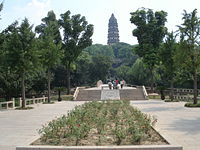
Huqiu Tower
Encyclopedia

Chinese pagoda
Chinese Pagodas are a traditional part of Chinese architecture. In addition to religious use, since ancient times Chinese pagodas have been praised for the spectacular views which they offer, and many famous poems in Chinese history attest to the joy of scaling pagodas.-History:The pagoda is...
situated at Changmen in Suzhou
Suzhou
Suzhou , previously transliterated as Su-chou, Suchow, and Soochow, is a major city located in the southeast of Jiangsu Province in Eastern China, located adjacent to Shanghai Municipality. The city is situated on the lower reaches of the Yangtze River and on the shores of Taihu Lake and is a part...
City, Jiangsu
Jiangsu
' is a province of the People's Republic of China, located along the east coast of the country. The name comes from jiang, short for the city of Jiangning , and su, for the city of Suzhou. The abbreviation for this province is "苏" , the second character of its name...
Province. It has several other names, including the 'Leaning Tower of China' (as referred to by historian O.G. Ingles) and the Yunyan Temple Tower. The tower was built in the later period of the Five Dynasties (907-960 CE), completed by the second year of the Song Dynasty
Song Dynasty
The Song Dynasty was a ruling dynasty in China between 960 and 1279; it succeeded the Five Dynasties and Ten Kingdoms Period, and was followed by the Yuan Dynasty. It was the first government in world history to issue banknotes or paper money, and the first Chinese government to establish a...
. The tower rises to a height of 47 m (154 ft). It is a seven-story octagonal building built with blue bricks. In more than a thousand years the tower has gradually slanted due to forces of nature. Now the top and bottom of the tower vary by 2.32 meters. The entire structure weighs some 7000000 kilograms (15,432,358.4 lb), supported by internal brick columns. However, the tower leans roughly 3 degrees due to the cracking of two supporting columns.
The tower leans because the foundation is originally half rock and the other half is on soil. In 1957, efforts were made to stabilize the tower and prevent further leaning. Concrete was also pumped into the soil forming a stronger foundation. During the reinforcement process, a stone casket containing Buddhist scriptures was found. The container had an inscription noting the completion date of the tower as the seventeenth day of the twelfth month of the second year of the reign of Jianlong (961 AD); according to O.G Ingles it was built in 959. O.G. Ingles writes that the better name for the Tiger Hill Pagoda should be the "'Leaning Tower of China', since it predates the famous Italian structure
Leaning Tower of Pisa
The Leaning Tower of Pisa or simply the Tower of Pisa is the campanile, or freestanding bell tower, of the cathedral of the Italian city of Pisa...
." The uppermost stories of the tower were built as an addition during the reign of the Chongzhen Emperor
Chongzhen Emperor
The Chongzhen Emperor was the 16th and last emperor of the Ming Dynasty in China. He reigned from 1627 to 1644, under an era name that means "honorable and auspicious".- Early years :...
(1628–1644), the last emperor of the Ming Dynasty
Ming Dynasty
The Ming Dynasty, also Empire of the Great Ming, was the ruling dynasty of China from 1368 to 1644, following the collapse of the Mongol-led Yuan Dynasty. The Ming, "one of the greatest eras of orderly government and social stability in human history", was the last dynasty in China ruled by ethnic...
.
As of September 2010 public access to the top of the tower is no longer allowed.
See also
- Leaning towerLeaning towerThis is a list of leaning towers. A leaning tower is a tower which, either intentionally, due to errors in design, construction or to subsequent external influence, does not stand perpendicular to the ground...
- Chinese architectureChinese architectureChinese architecture refers to a style of architecture that has taken shape in East Asia over many centuries. The structural principles of Chinese architecture have remained largely unchanged, the main changes being only the decorative details...
- Architecture of the Song DynastyArchitecture of the Song DynastyThe architecture of the Song Dynasty was noted for its towering Buddhist pagodas, enormous stone and wooden bridges, lavish tombs, and palaces. Although literary works on architecture existed beforehand, architectural writing blossomed during the Song Dynasty, maturing into a more professional...

